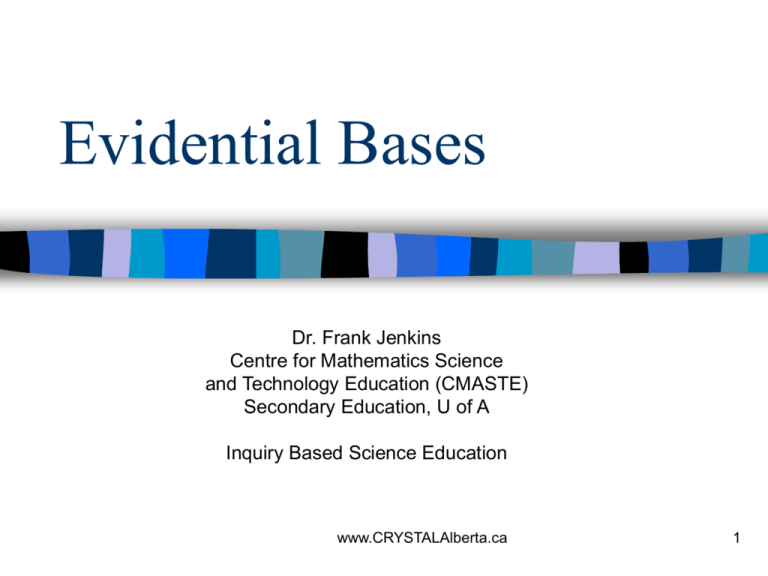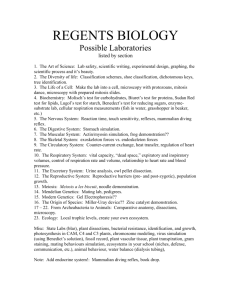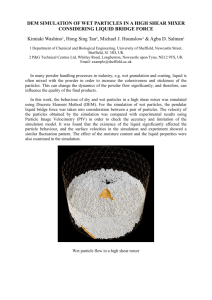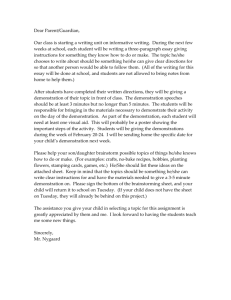Evidential Bases
advertisement

Evidential Bases Dr. Frank Jenkins Centre for Mathematics Science and Technology Education (CMASTE) Secondary Education, U of A Inquiry Based Science Education www.CRYSTALAlberta.ca 1 Evidence-Based Reasoning There is evidence to suggest that many undergraduate students (and the public) who do not understand the importance of evidence-based reasoning; e.g., psychic fairs, pseudoscience, astrology television shows and movies lack of understanding of what research is about in their field of work www.CRYSTALAlberta.ca 2 Potential Evidential Bases 1. 2. 3. 4. 5. thought experiment demonstration dry lab (lab exercise) wet lab (actual) simulation/ animation video analysis 7. video lab 8. computer probes/sensors 9. field trip 10. remote access 6. www.CRYSTALAlberta.ca 3 1. Thought Experiment The most famous person to use thought experiments extensively was Albert Einstein; e.g., concept of relativity. The teacher/scientist draws a diagram (or waves her hands) and describes an experiment that is imaginary. Evidence is often is the form of “If we double this variable, what happens?” www.CRYSTALAlberta.ca 4 2. Demonstration The teacher or a student or group of students conduct an experiment in front of a science class. Often done because of lack of equipment for the whole class. Sometimes there are safety issues and the teacher conducts the experiment. www.CRYSTALAlberta.ca 5 3. Dry Lab (Lab Exercise) This is a pencil and paper lab experience where parts of a lab report are presented for students to complete. Often the evidence is given for analysis. Used for exercises, homework, and examination questions. Often presented as open entry. www.CRYSTALAlberta.ca 6 4. Wet Lab (laboratory experience) This is a hands-on individual (or small group) student laboratory experience. Wet lab is a chemistry expression. Ideally this is the kind of lab experience that is available to all students. Sometimes this experience is provided at home or some alternative location. www.CRYSTALAlberta.ca 7 5. Field Trip (field work) This evidence gathering experience involves leaving the school. Often a nature field trip. Can be a trip to an alternative location (e.g., a university) to use equipment. In this context the field trip must involve gathering evidence to be analyzed. www.CRYSTALAlberta.ca 8 6. Video/Photo Lab Evidence is presented through a video. Easier done with qualitative evidence. Can involve quantitative evidence. Any lab experience can be videoed. Some of these experiences are available on video tape or disk. Some experiences are on the Internet. www.CRYSTALAlberta.ca 9 7. Computer Video Analysis Computer programs are available that present video from which evidence is gathered; e.g., every fraction of a second for the motion of an object. The computer program generates tables and graphs of evidence. The computer program often provides an analysis of evidence and graphing. www.CRYSTALAlberta.ca 10 8. Computer Simulations Computer simulations or animations are often referred to as learning objects. The laboratory equipment may be animated and appear to generate table of evidence and graphs. The evidence may or may not have any measurement error programmed in. www.CRYSTALAlberta.ca 11 9. Computer Probes/Sensors Probes are attached to a computer or like device; e.g., temperature and pH. Evidence is gathered by the computer and presented in tables and/or graphs. Evidence can be gathered in the field and then transferred to a computer. Evidence can be gathered for 24 h+. www.CRYSTALAlberta.ca 12 10. Remote Laboratory Work Laboratory work is conducted over the Internet, connected to equipment. One is able to adjust the variables and gather the evidence as if being there. An example would be to conduct an e/m experiment by manipulating the electric and magnet fields and measuring the curvature of an electron beam, remotely. www.CRYSTALAlberta.ca 13 E.g. 1: Vertically Thrown Ball (How would you do it?) 1. 2. Thought Experiment – imagine ball in air – students predict – students take notes Demonstration – teacher throws ball – students observe and gather evidence 3. 4. 5. Dry Lab (lab exercise) – paper and pencil – evidence provided – constructivist lesson Wet Lab (in the lab) – Students gather their own evidence in the laboratory. Simulation – www.CRYSTALAlberta.ca Evidence comes from the computer simulation. 14 E.g. 1: Vertically Thrown Ball (How would you do it?) 6. Video analysis – – 8. video provided Computer is used to help analyze the video; e.g., Motion CD. Probeware – – 9. Field trip – 7. Video/photo lab – – video/photo is provided Students observe video and gather evidence from it. – 10. computer required Probes/sensors gather the evidence. Evidence is gathered by going to a remote site. E.g., ride or water park Remote access – www.CRYSTALAlberta.ca Internet access to equipment that is manipulated remotely 15 E.g., 2 - e/m ratio of the electron (How would you do it?) 1. 2. 3. 4. 5. thought experiment demonstration dry lab (lab exercise) wet lab (actual) simulation/ animation video analysis 7. video/photo lab 8. computer probes/sensors 9. field trip 10. remote access 6. www.CRYSTALAlberta.ca 16 Photolab & Simulation Hybrid: e/m lab (combinations of EBs are possible) www.CRYSTALAlberta.ca 17 Your Turn: Where can we get the evidence on stoichiometry? 1. 2. 3. 4. 5. thought experiment demonstration dry lab (lab exercise) wet lab (actual) simulation/ animation video analysis 7. video lab 8. computer probes/sensors 9. field trip 10. remote access 6. www.CRYSTALAlberta.ca 18 Stoichiometry Investigations: CTU Create (inductively) – create the stoichiometric law Test (hypothetico-inductively) – test the hypothesis created above Test (hypothetico-deductively) – test a prediction from the hypothesis Use (deductively) – use the well-tested stoichiometric law www.CRYSTALAlberta.ca 19 Evidential Bases for CTU Cycle Laws Stoichiometry Equilibrium Spontaneity —the law —the law —the law Create thought (C) Test experiment (same evidence) (same evidence) dry lab wet lab video lab demonstration simulation computer probes (T) (verify) Use (U) Test (falsify) wet lab (assumption of quantitative) photo lab (assumption of spontaneity) www.CRYSTALAlberta.ca wet lab (assumption of rate rate law) 20 Evidential Bases for CTU Cycle Lab Type Arrhenius Concept Create computer animation (I) BronstedLowry A-B Lewis A-B Concept use falsifying evidence use falsifying evidence verify in the laboratory verify in a Test verify in the (HI/HD) demonstration Use qualitative in computer analysis in lab simulation exercise qualitative analysis in the laboratory falsify in the laboratory falsify in a video lab (D) Test (HI/HD) falsify in a demonstration www.CRYSTALAlberta.ca demonstration 21 Evidential Bases (Can hardly wait to see what you do with this concept.) 1. 2. 3. 4. 5. thought experiment demonstration dry lab (lab exercise) wet lab simulation/ animation video analysis 7. video lab 8. computer probes/sensors 9. field trip 10. remote access 6. www.CRYSTALAlberta.ca 22 Evidential Bases: why? Evidence is central to science. Evidence-based reasoning is one of the foundations of all subject disciplines. There is now no excuse for not gathering, analyzing and evaluating evidence. More evidence has to be gathered than time permits through wet labs. www.CRYSTALAlberta.ca 23




